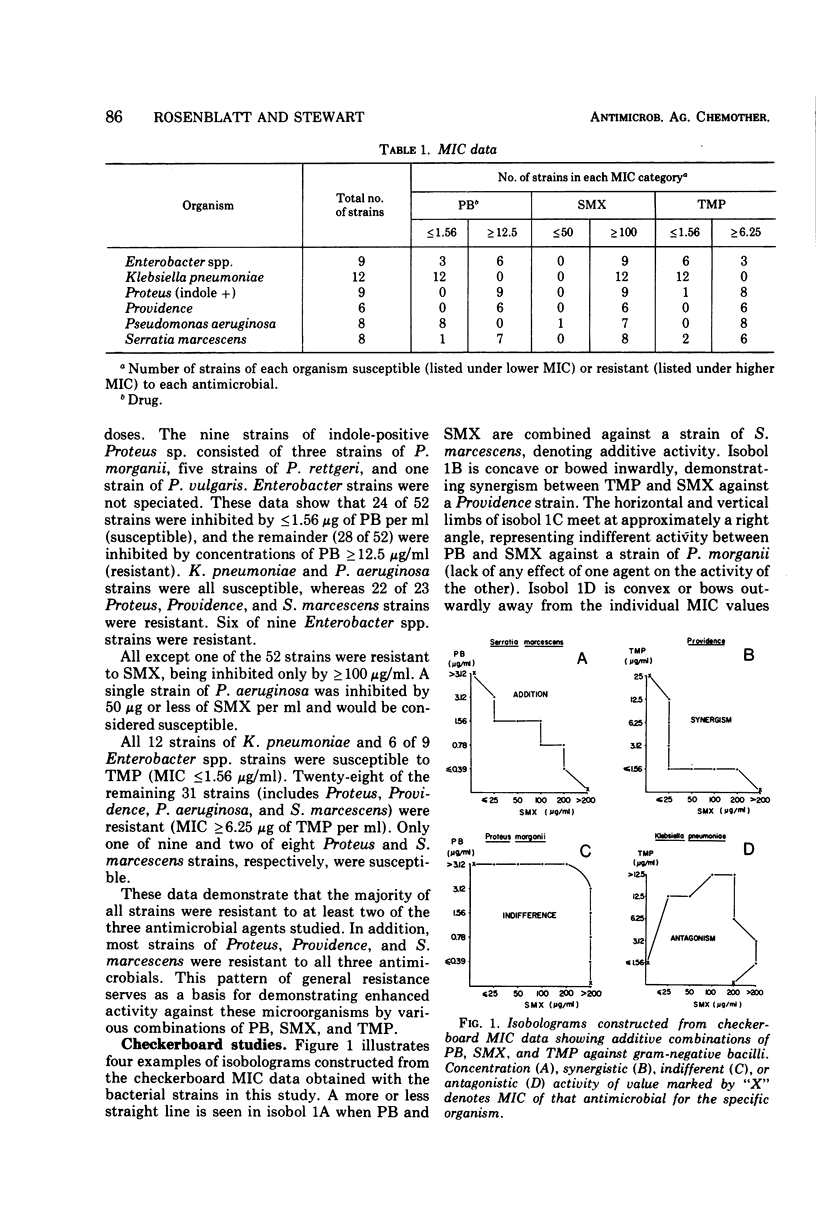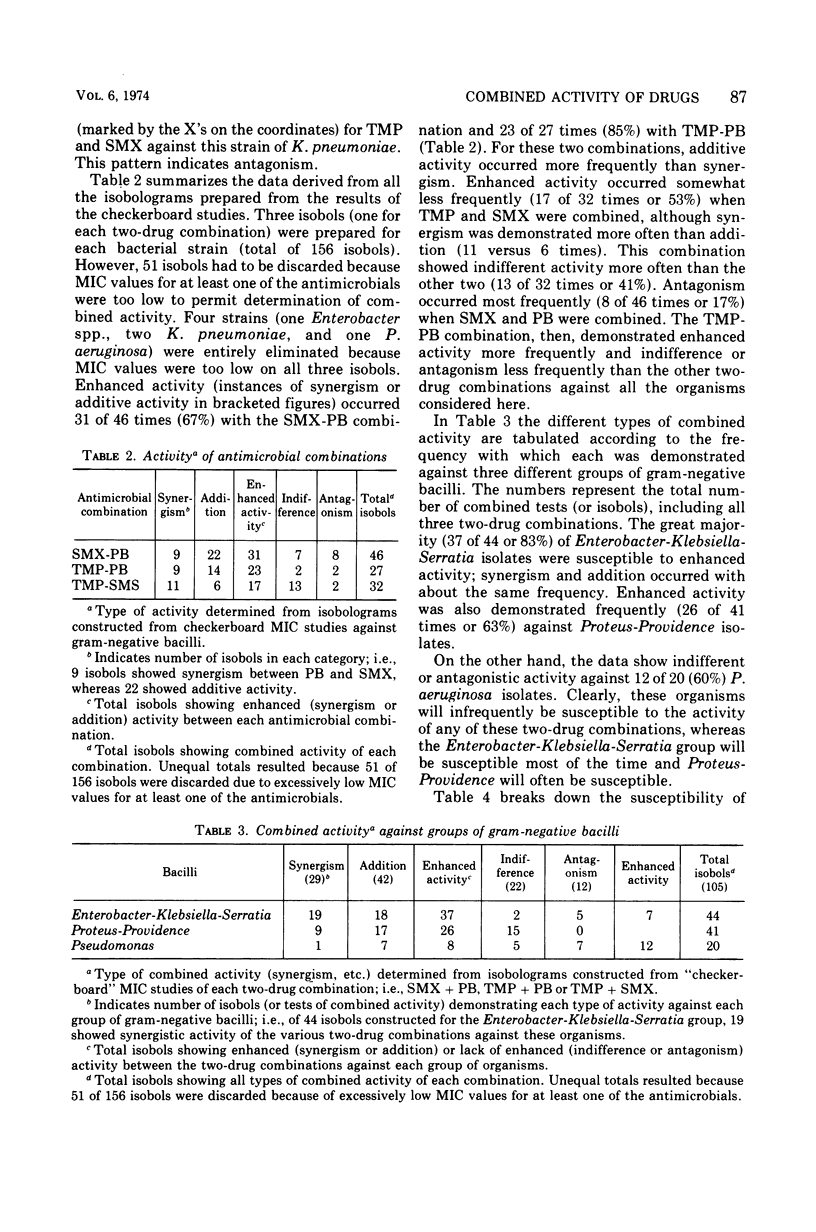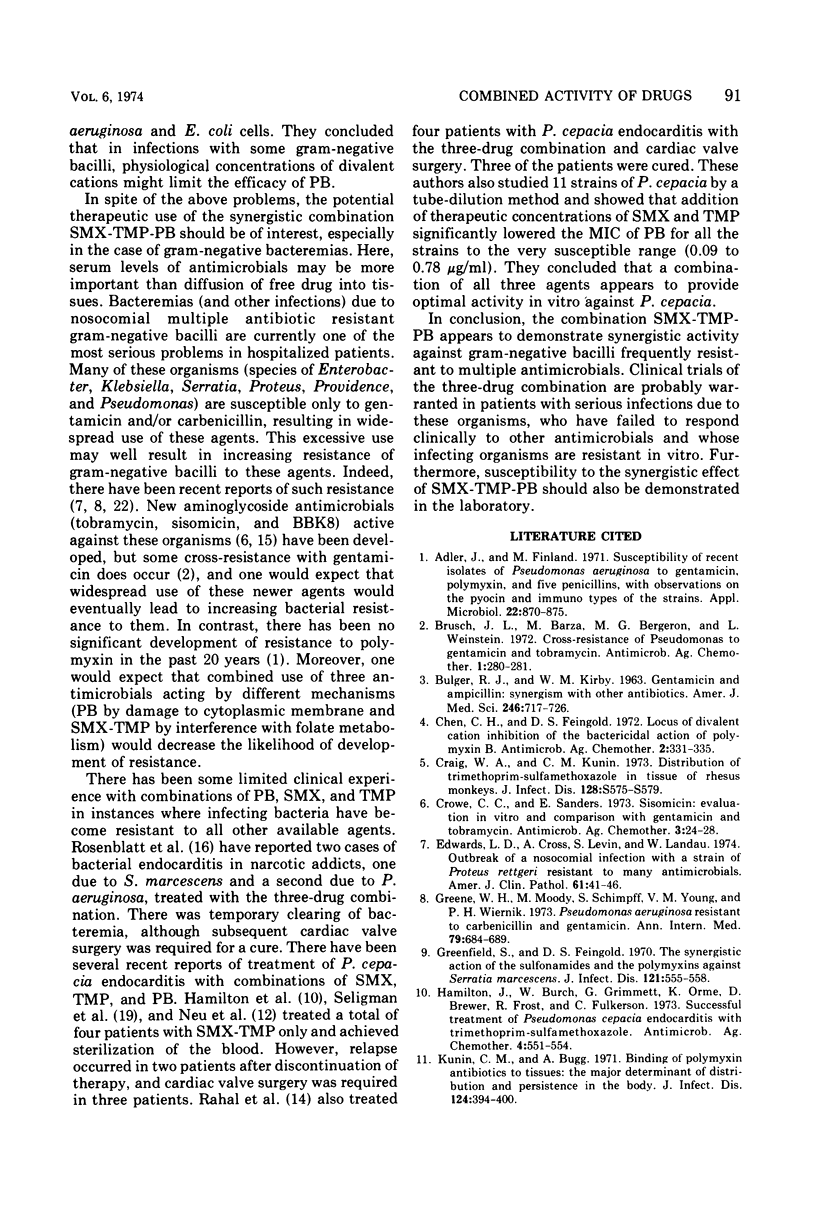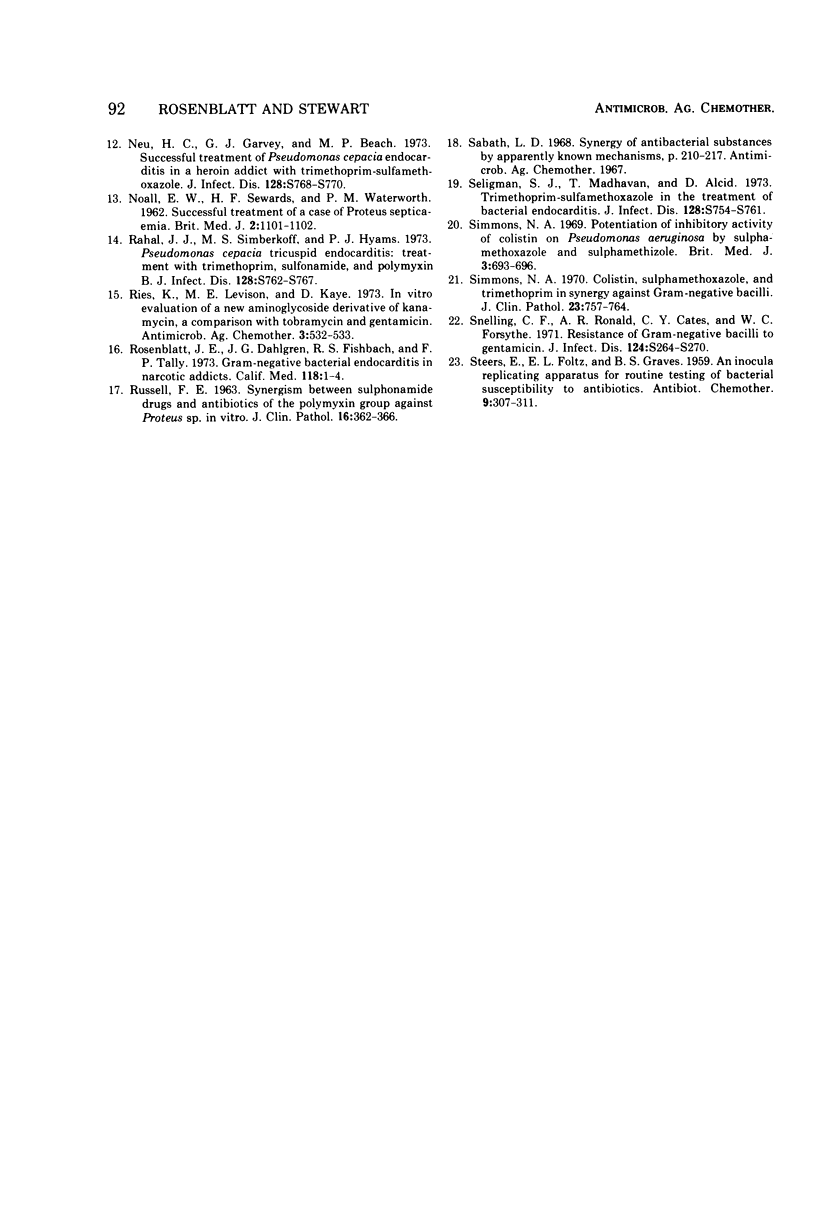Abstract
The activity of the three two-drug combinations of sulfamethoxazole (SMX), trimethoprim (TMP), and polymyxin B (PB) against 52 clinical isolates of gram-negative bacilli was studied by a “checkerboard” agar dilution method. The organisms studied included strains of Enterobacter spp., Klebsiella pneumoniae, Serratia marcescens, Providence, Proteus, and Pseudomonas aeruginosa. The majority of these isolates were resistant to at least two of the three agents used in the combined studies and to the most commonly used antimicrobials. The TMP-PB combination demonstrated enhanced activity more frequently than the other two-drug combinations, showing synergism or addition in 85% of the combined studies; indifference or antagonism was also observed least frequently with TMP-PB. The great majority (83%) of Enterobacter-Klebsiella-Serratia isolates were susceptible to enhanced activity of all combinations. Proteus-Providence isolates were frequently susceptible (63%), but combined activity was indifferent or antagonistic against 60% of P. aeruginosa. Twelve isolates were selected for “killing-curve” assays in which an inoculum was incubated with SMX, TMP, and PB individually and in various two- and three-drug combinations. Surviving bacteria were counted at timed intervals over 24 h of incubation. The triple combination (SMX-TMP-PB) was synergistic against 9 of 12 isolates, whereas TMP-PB and SMX-PB showed synergism against 5 and 3 isolates, respectively. These data suggest that, although TMP-PB will often show enhanced activity against the gram-negative bacilli studied here, optimal antibacterial activity will be demonstrated when the three-drug combination is used.
Full text
PDF








Selected References
These references are in PubMed. This may not be the complete list of references from this article.
- Adler J. L., Finland M. Susceptibility of recent isolates of Pseudomonas aeruginosa to gentamicin, polymyxin, and five penicillins, with observations on the pyocin and immunotypes of the strains. Appl Microbiol. 1971 Nov;22(5):870–875. doi: 10.1128/am.22.5.870-875.1971. [DOI] [PMC free article] [PubMed] [Google Scholar]
- BULGER R. J., KIRBY W. M. GENTAMICIN AND AMPICILLIN: SYNERGISM WITH OTHER ANTIBIOTICS. Am J Med Sci. 1963 Dec;246:717–726. doi: 10.1097/00000441-196312000-00013. [DOI] [PubMed] [Google Scholar]
- Brusch J. L., Barza M., Bergeron M. G., Weinstein L. Cross-resistance of Pseudomonas to gentamicin and tobramycin. Antimicrob Agents Chemother. 1972 Mar;1(3):280–281. doi: 10.1128/aac.1.3.280. [DOI] [PMC free article] [PubMed] [Google Scholar]
- Chen C. C., Feingold D. S. Locus of divalent cation inhibition of the bactericidal action of polymyxin B. Antimicrob Agents Chemother. 1972 Nov;2(5):331–335. doi: 10.1128/aac.2.5.331. [DOI] [PMC free article] [PubMed] [Google Scholar]
- Crowe C. C., Sanders E. Sisomicin: evaluation in vitro and comparison with gentamicin and tobramycin. Antimicrob Agents Chemother. 1973 Jan;3(1):24–28. doi: 10.1128/aac.3.1.24. [DOI] [PMC free article] [PubMed] [Google Scholar]
- Edwards L. D., Cross A., Levin S., Landau W. Outbreak of a nosocomial infection with a strain of Proteus rettgeri resistant to many antimicrobials. Am J Clin Pathol. 1974 Jan;61(1):41–46. doi: 10.1093/ajcp/61.1.41. [DOI] [PubMed] [Google Scholar]
- Greene W. H., Moody M., Schimpff S., Young V. M., Wiernik P. H. Pseudomonas aeruginosa resistant to carbenicillin and gentamicin. Epidemiologic and clinical aspects in a cancer center. Ann Intern Med. 1973 Nov;79(5):684–689. doi: 10.7326/0003-4819-79-5-684. [DOI] [PubMed] [Google Scholar]
- Greenfield S., Feingold D. S. The synergistic action of the sulfonamides and the polymyxins against Serratia marcescens. J Infect Dis. 1970 May;121(5):555–558. doi: 10.1093/infdis/121.5.555. [DOI] [PubMed] [Google Scholar]
- Hamilton J., Burch W., Grimmett G., Orme K., Brewer D., Frost R., Fulkerson C. Successful treatment of Pseudomonas cepacia endocarditis with trimethoprim-sulfamethoxazole. Antimicrob Agents Chemother. 1973 Nov;4(5):551–554. doi: 10.1128/aac.4.5.551. [DOI] [PMC free article] [PubMed] [Google Scholar]
- Kunin C. M., Bugg A. Binding of polymyxin antibiotics to tissues: the major determinant of distribution and persistence in the body. J Infect Dis. 1971 Oct;124(4):394–400. doi: 10.1093/infdis/124.4.394. [DOI] [PubMed] [Google Scholar]
- Noall E. W., Sewards H. F., Waterworth P. M. Successful Treatment of a Case of Proteus Septicaemia. Br Med J. 1962 Oct 27;2(5312):1101–1102. doi: 10.1136/bmj.2.5312.1101. [DOI] [PMC free article] [PubMed] [Google Scholar]
- RUSSELL F. E. SYNERGISM BETWEEN SULPHONAMIDE DRUGS AND ANTIBIOTICS OF THE POLYMYXIN GROUP AGAINST PROTEUS SP. IN VITRO. J Clin Pathol. 1963 Jul;16:362–366. doi: 10.1136/jcp.16.4.362. [DOI] [PMC free article] [PubMed] [Google Scholar]
- Ries K., Levison M. E., Kaye D. In vitro evaluation of a new aminoglycoside derivative of kanamycin, a comparison with tobramycin and gentamycin. Antimicrob Agents Chemother. 1973 Apr;3(4):532–533. doi: 10.1128/aac.3.4.532. [DOI] [PMC free article] [PubMed] [Google Scholar]
- Rosenblatt J. E., Dahlgren J. G., Fishbach R. S., Tally F. P. Gram-negative bacterial endocarditis in narcotic addicts. Calif Med. 1973 Feb;118(2):1–4. [PMC free article] [PubMed] [Google Scholar]
- Simmons N. A. Colistin, sulphamethoxazole, and trimethoprim in synergy against Gram-negative bacteria. J Clin Pathol. 1970 Dec;23(9):757–764. doi: 10.1136/jcp.23.9.757. [DOI] [PMC free article] [PubMed] [Google Scholar]
- Simmons N. A. Potentiation of inhibitory activity of colistin on Pseudomonas aeruginosa by sulphamethoxazole and sulphamethizole. Br Med J. 1969 Sep 20;3(5672):693–696. doi: 10.1136/bmj.3.5672.692. [DOI] [PMC free article] [PubMed] [Google Scholar]
- Snelling C. F., Ronald A. R., Cates C. Y., Forsythe W. C. Resistance of gram-negative bacilli to gentamicin. J Infect Dis. 1971 Dec;124 (Suppl):S264–S270. doi: 10.1093/infdis/124.supplement_1.s264. [DOI] [PubMed] [Google Scholar]


